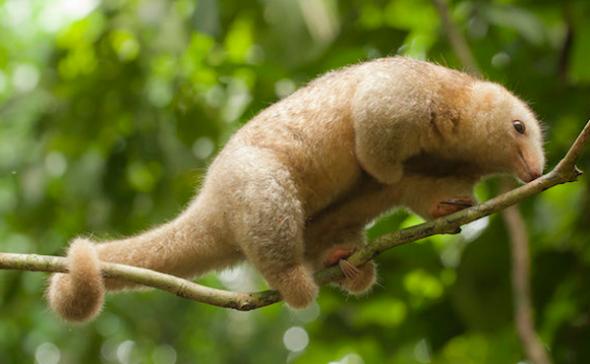 Silky Anteater Silky AnteaterCyclopes
didactylus
Description
This anteater's coat is
dense, soft, and silky (hence the name
"silky anteater"), and ranges in color
from grey to golden yellow. Its ears are short
and rounded and the eyes are small and black.
Large curved, sharp claws are present on the
second and third fingers of the feet. This is the
only anteater that doesn't possess any teeth.
With a maximum length of 19 inches (including
a prehensile tail up to 10 inches long), this is
the smallest anteater (giving it the alternative
name of "pygmy anteater").
Distribution and Habitat
The silky anteater ranges from
southern Mexico to Bolivia. It inhabits a
range of different forest types, including
semideciduous, tropical evergreen, and mangrove
forests. Individuals have been sighted in
altitudes ranging from sea level to almost 5,000
feet. It is most commonly found in Ceiba
trees, which have large seed pods that contain
masses of a silky silverish fiber that almost
exactly match the animal's fur color.
Diet
The silky anteater feeds mostly on arboreal
ants and termites, but has been known to
occasionally eat coccinellid beetles. It is an
opportunistic feeder that forages among the
treetops and invades ants nests with its long
sticky tongue.
Reproduction
A single offspring is born
after a gestation period of about 135 days,
usually in September or October. The young is
placed in a nest of dry leaves in a hole
in a tree trunk, where it is cared for by both
parents. It is fed regurgitated semi-digested
insects until reaching about one-third of the
adult mass. It begins to go out on its own at
about nine months of age, and is fully-grown and
independent at one year.
Other Habits and
Behaviors
Its small size and almost
entirely arboreal lifestyle makes the silky
anteater difficult to see and study in the wild.
It is known, however, that it is nocturnal,
solitary (except when breeding and raising
offspring), and slow-moving.
Males have a home range of 11 hectares and
overlap the home ranges of several females, which
are approximately 3 hectares. Individuals of the
same sex do not have overlapping home ranges.
When threatened, the silky anteater stands on
its hind legs and grasps tree limbs with its hind
feet and prehensile tail. It then hold its
forefeet close to its face and strikes very
quickly with its large claws. Its main predators
are birds, including the harpy eagle, eagle hawks
and the speckled owl.
Scientific
Classification
phylum Chordata
subphylum Vertebrata
class Mammalia
order Pilosa
family Cyclopedidae
genus & species Cyclopes didactylus

Animal Diversity Web http://animaldiversity.org/accounts/Cyclopes_didactylus/
Questions or comments about
this page?
|



